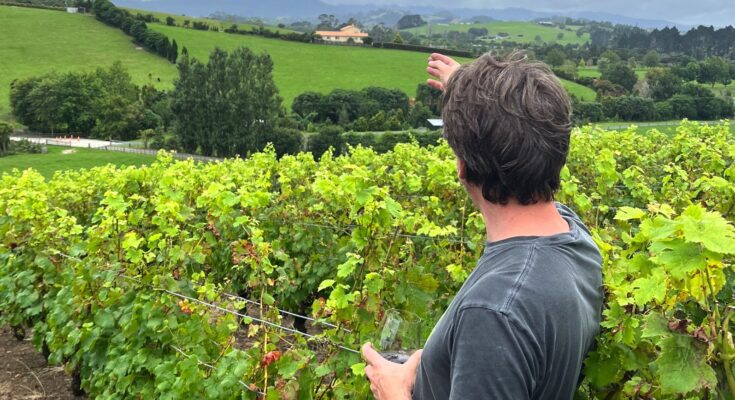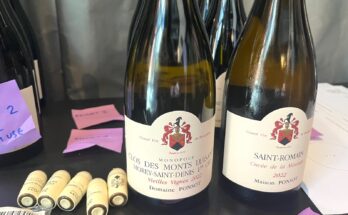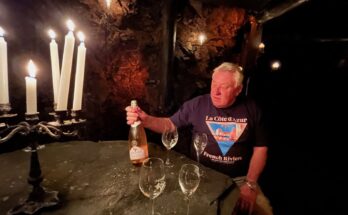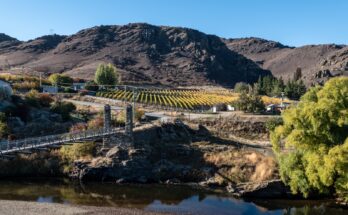A trip up to Matakana earlier in the year gave me a chance to pop in and see Toby Gillman at his family vineyard. The year has been a write-off for weather and Toby starts by telling us the bad news… that they won’t make any wine this year. The better news is that he has a decent stock of vintage wines that he’s happy to show! Asked if there’s anything that I’d like to try, I suggest maybe looking at a cooler versus a warmer vintage? Toby suggests a 2010 as a ripe option, and a 2017. He notes that “2017 was previously our wettest vintage – I think this year is going to take that crown”.
With a glass of that in hand, we take a walk down to the vineyard and there is talk of the vines that are going to be replanted. Some more Cabernet Franc, but also “I’ve got the space, but if I had money to plant the rest of it I’d put some white in. I wouldn’t mind doing a Sauvignon-Semillon actually. I like white Bordeaux”. The original plantings were two-thirds Franc, and the rest as Merlot, with a bit of Malbec. They’re now replacing the Malbec with Petit Verdot and increasing the Franc – which will end up about 85%.
The vines aren’t looking at their best, but Toby is philosophical: “You can see the leaf damage. It’s very unusual. I think it is a combination of the wind but also a bit of powdery in there. It is what it is. I’m pretty sure I’m not going to pick anything this year. And that gives me a bit more freedom to spray something a bit more hardcore and clean up all the fungal disease”.
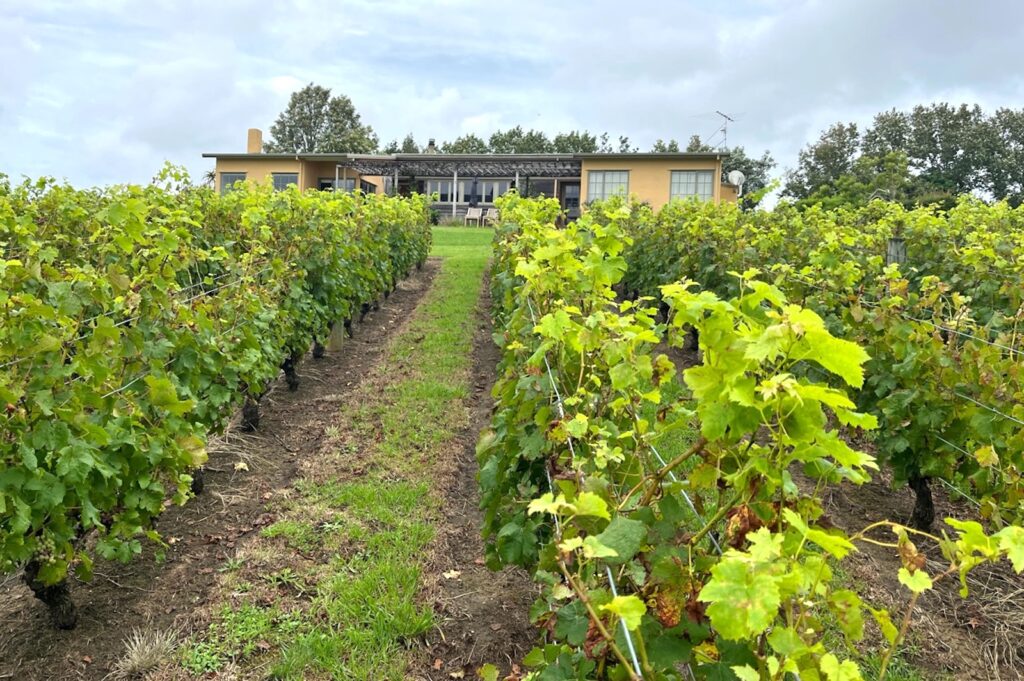
The vineyard faces just a bit west off true north. The afternoon sun packs a bit more heat – giving more UV on the north east and more infra-red from the north west. The UV gives you sugars, but you need the heat on the skins to develop the tannins in your reds. I ask Toby if there was a wine that he aspired towards for his wines – like Cheval Blanc – and he replies “Cheval Blanc definitely, because of the Cabernet Franc, but also the approachability when it is young”.
The vineyard was originally a horse paddock. Toby learnt to make wine at Providence Vineyard, about 3kms across the way. One day he and his Dad were driving around the area, with the idea that his parents would retire up to Matakana, and Toby would develop a vineyard. They spent around two years looking at what was on the market, but couldn’t find anything suitable.
“We’d drive around with a spade and a post hole borer. Jump some fences and start digging around – see if it was worth approaching the farmer. But nothing really panned out. The problem is the clay. You can put a bore down and it could be a hundred metres before it hits any rock. The top metre or so is granular orange iron-rich clay. But we’d look at a place and go in with a digger, and two metres down we’d keep hitting this sticky stuff underneath. You can make porcelain out of it! At Providence they’ve got this pink, sandy loam and it is from a volcanic explosion a few hundred miles south. You’ve got it on the south-facing slopes, and you’ll see it in the cuttings as you drive around, but in the lee of the explosion – on north-facing slopes – it tends to disappear. So it was really hard to find a north-facing slope that had it underneath”.
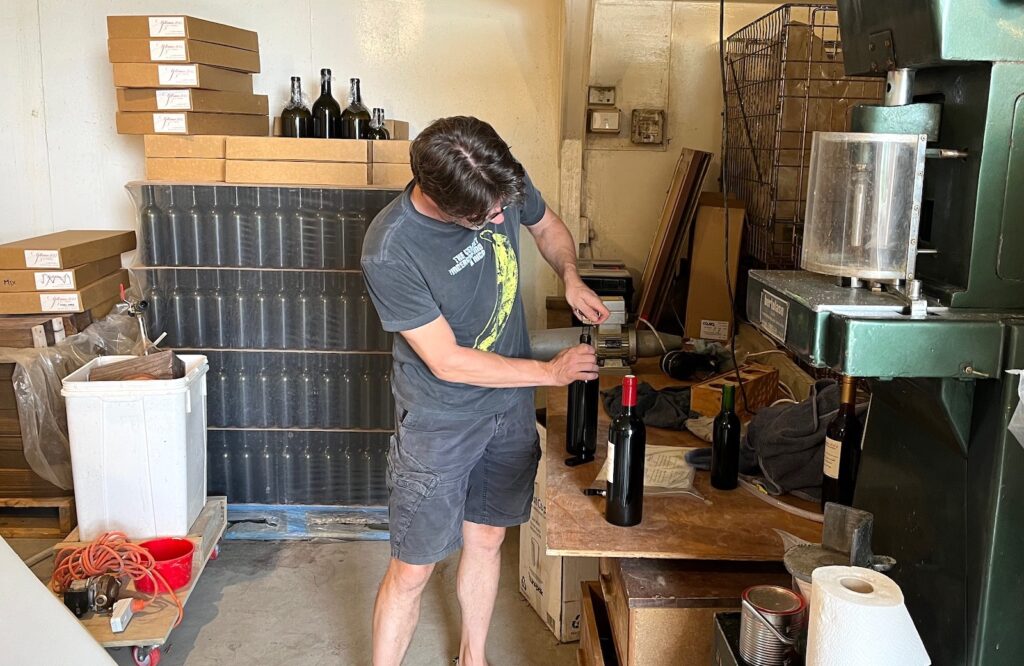
The winery is appropriately small. When they are picking, the front area becomes the reception area for fruit, with sorting tables and the de-stemmer set up. We settle in and try a 2007 – which was a really dry, drawn-out year – with a drought that threatened to shut the vines down, until a period of rain came along, leading into a nice, warm autumn. There’s a swag of aged, secondary character to it, but a kirsch cherry offers an initial pop of fruit. Good structure, with the oak quite noticeable, but overall softly balanced with acidity and tannin all aligned.
In an average year, they would make around 2000 bottles, but with half the vineyard decommissioned at the moment, it has been more like a thousand bottles a year. There is also pressure from birds, but Toby hasn’t always put up nets in the past, as it can cut out some sunlight. This isn’t a problem when things are ripening quickly, in hot years. With the wider nets now more available, he’ll be able to net off multiple rows, which he finds more appealing. There is the risk of having a burst of rain and the vines shoot off, growing through the nets, so Toby talks of the idea of putting up wooden post extensions, and stringing ropes across to hold the nets up. “We’ll find out next year if it works!” he adds.
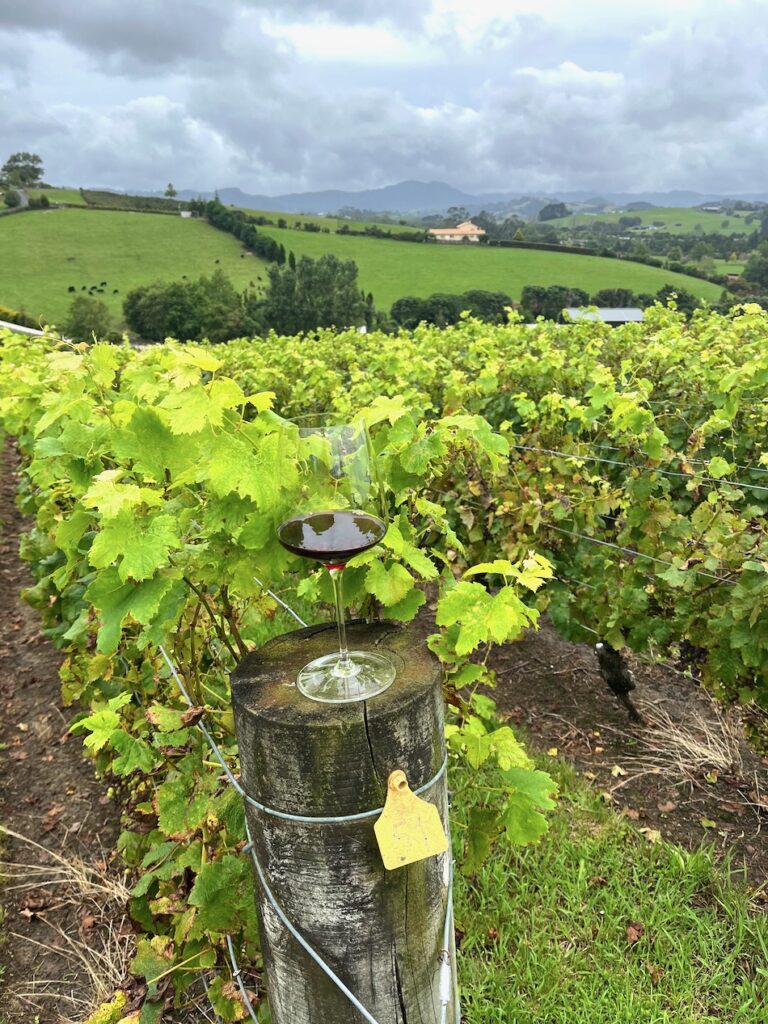
They have tried shooting at the birds, but apparently they now have a problem with Mynahs that have flocked to the trees across the gully. As soon as Toby heads out of the vineyard, they will fly in, and if he comes back their sentry will alert them all to fly off again! They’ve decimated the bottom third of the vineyard.
A 2010 bottle is opened, and it shows that vintage off very well. A year when it was possible to get fruit ripe and plush. It doesn’t quite have the complexity on the nose that the 2007 showed; but the structure is so firm and tight, that I’d think it will go for another twenty years, easily. Speaking of which – I ask about the future of Gillman Estate, and Matakana in general.
Toby is again quite frank: “I need to expand to be profitable. But I just don’t have the time or money. If I found the right partner I’d think about it, but it would have to be the right person. And everything just gets more expensive. Even things like earthmoving. When I established this in the ‘90s it was about a thousand dollars a row – the way we planted. And now the earthworks alone would be a hundred grand – for that extra acre. Vines have doubled in price.
Matakana went backwards for a while. Ransom has gone. Matakana Estate has been taken over but is mostly bringing in grapes from Hawke’s Bay and Marlborough. It says Matakana on the front but ‘product of Hawke’s Bay’ on the back. I associate Matakana – the place – with wine – because I’m out here making wine. But most people don’t. There was an article about Matakana in North and South magazine – it was on the cover. There was a little thing about Heron’s Flight and that was it. A story about Brick Bay that didn’t even mention that they made wine! It’s off people’s radar and not considered a wine destination. Everyone goes to the Market and then Omaha Beach. I don’t know.
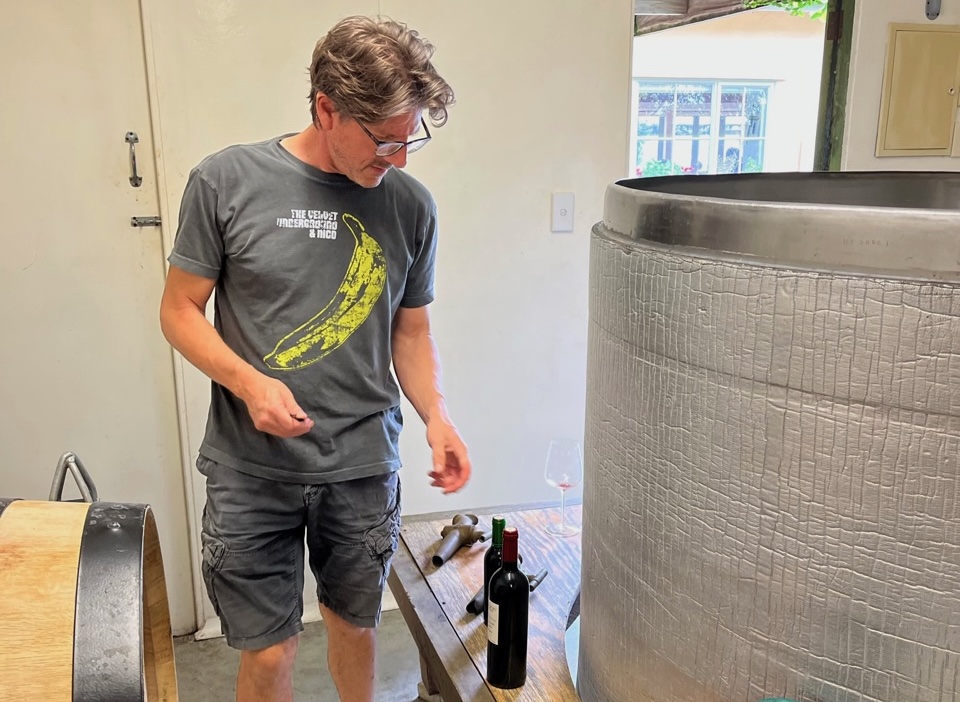
There are a few people doing stuff though. Karl Nola over towards Leigh has some Marsanne, Chenin Blanc, Viognier, Syrah and Tempranillo. Dave is still doing Heron’s Flight. I guess the few big players that came in – big by Matakana standards – have stopped. It’s not commercially viable unless you’re doing something special – it just doesn’t work.”

